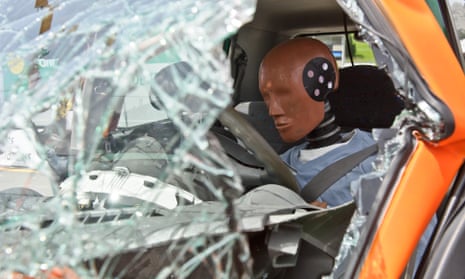Women are almost twice as likely as men to become trapped in a motor vehicle after a crash and they also sustain different patterns of injury, data suggests.
The research – the first large UK study to compare sex differences in injury patterns and the likelihood of becoming trapped after a collision – could help vehicle manufacturers improve car design and safety features to reduce rates of injury in both sexes. It also strengthens calls for the inclusion of more biologically accurate crash test dummies in simulations of vehicle collisions, to investigate their impact on women.
Prof Tim Nutbeam, an emergency medicine consultant at University Hospitals Plymouth, and colleagues were motivated to carry out the study after reading Caroline Criado Perez’s bestselling book Invisible Women, which highlighted how women were more likely to be seriously injured in car crashes, because crash test dummies were modelled on the “average male”.
To investigate, they looked at data from 70,027 patients admitted to major trauma centres and units in the UK between January 2012 and December 2019.
They found that although men were more likely to be involved in serious crashes and admitted to hospital, 16% of women became trapped in the wreckage, versus only 9% of men. Women also sustained more hip and spinal injuries, whereas men suffered more head, face, chest and limb injuries. The research was published in BMJ Open.
“I think the important bit is that it shows that women and men have different experiences of entrapment – that a trapped woman is not the same as a trapped man,” said Dr Lauren Weekes, a consultant anaesthetist at University Hospitals Plymouth, who was also involved in the study.
“Understanding sex differences in injury patterns may help paramedics predict who is more likely to have certain injuries, which could have implications for how you help them out, and where you end up taking them. It may also help vehicle manufacturers direct safety systems to protect men and women equally.”
One possibility is that the nature of women’s injuries makes it harder for them to escape the wreckage. “For example, women have a much higher rate of pelvic injury, and it’s harder to get yourself out of a car yourself if you’ve broken your pelvis,” Weekes said.
Differences in the way men and women drive could also be a factor, with men involved in more frontal collisions, and more likely to be in the driver’s seat, compared with women, and therefore more likely to be injured by hitting the steering wheel or air bag. Also, if women are driving, they tend to have their seat positioned closer to the steering wheel, which could contribute to them becoming trapped.
However, differences in body shape are also likely to come into play, and these are not accurately modelled in simulations of vehicle crashes. Weekes said: “We know that women’s pelvises, even correcting for height and weight, are much wider than men’s, so the crash test dummies used to simulate accidents are more like a 12-year-old prepubescent girl than an adult female. If you think about where a woman’s pelvis is likely to be in relation to the door, it is going to be closer.
“Crash tests are standardised, and therefore the data from those should be able to protect men and women equally. But if manufacturers are not using biologically accurate dummies, how do they know that this is the case?”
Criado Perez said she hoped the study would also put pressure on regulators to take the issue seriously: “The EU is currently in the process of introducing new legislation, which for the first time will say that female car occupants must be as protected as male occupants – but the UK is currently not intending to adopt this,” she said. “I really hope that this kind of research will focus the minds of those in government who have the power to ensure that women are no longer disproportionately and needlessly injured and killed in the event of a car crash.”








